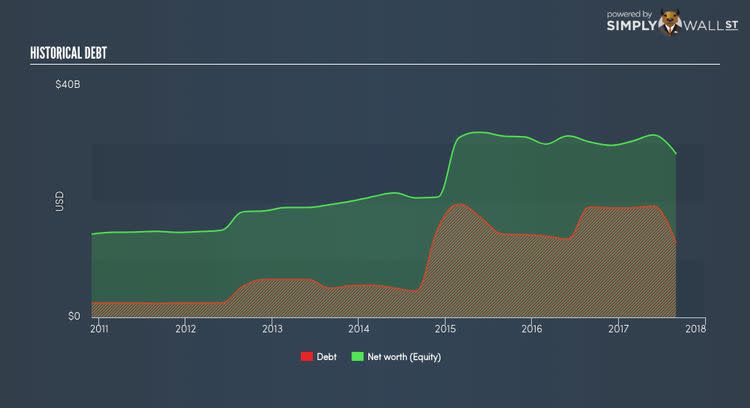What Investors Should Know About Walgreens Boots Alliance Inc’s (WBA) Financial Strength

There are a number of reasons that attract investors towards large-cap companies such as Walgreens Boots Alliance Inc (NASDAQ:WBA), with a market cap of USD $71.84B. One such reason is its ‘too big to fail’ aura which gives it the appearance of a strong and healthy investment. However, investors may not be aware of the metrics used to measure financial health. Why is it important? A major downturn in the energy industry has resulted in over 150 companies going bankrupt and has put more than 100 on the verge of a collapse, primarily due to excessive debt. Thus, it becomes utmost important for an investor to test a company’s resilience for such contingencies. In simple terms, I believe these three small calculations tell most of the story you need to know. Check out our latest analysis for Walgreens Boots Alliance
Is WBA’s level of debt at an acceptable level?
What is considered a high debt-to-equity ratio differs depending on the industry, because some industries tend to utilize more debt financing than others. Generally, large-cap stocks are considered financially healthy if its ratio is below 40%. In the case of WBA, the debt-to-equity ratio is 45.75%, which means, while the company’s debt could pose a problem for its earnings stability, it is not at an alarmingly high level yet. We can test if WBA’s debt levels are sustainable by measuring interest payments against earnings of a company. Ideally, earnings should cover interest by at least three times, therefore reducing concerns when profit is highly volatile. WBA’s profits amply covers interest at 9.75 times, which is seen as relatively safe. Debtors may be willing to loan the company more money, giving WBA ample headroom to grow its debt facilities.
How does WBA’s operating cash flow stack up against its debt?
A simple way to determine whether the company has put debt into good use is to look at its operating cash flow against its debt obligation. This is also a test for whether WBA has the ability to repay its debt with cash from its business, which is less of a concern for large companies. In the case of WBA, operating cash flow turned out to be 0.56x its debt level over the past twelve months. A ratio of over 0.5x is a positive sign and shows that WBA is generating more than enough cash from its core business, which should increase its potential to pay back near-term debt.
Next Steps:
Are you a shareholder? WBA’s high cash coverage means that, although its debt levels are high, investors shouldn’t panic since the company is able to utilise its borrowings efficiently in order to generate cash flow. Given that WBA’s financial position may differ over time, I suggest assessing market expectations for WBA’s future growth on our free analysis platform.
Are you a potential investor? While understanding the serviceability of debt is important when evaluating which companies are viable investments, it shouldn’t be the deciding factor. After all, debt financing is an important source of funding for companies seeking to grow through new projects and investments. That’s why I encourage potential investors to examine WBA’s Return on Capital Employed (ROCE) in order to see management’s track record at deploying funds in high-returning projects.
To help readers see pass the short term volatility of the financial market, we aim to bring you a long-term focused research analysis purely driven by fundamental data. Note that our analysis does not factor in the latest price sensitive company announcements.
The author is an independent contributor and at the time of publication had no position in the stocks mentioned.

